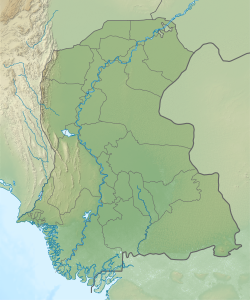|
Karampur
Karampur is a village and deh in Sehwan taluka of Jamshoro District, Sindh.[3] Said to have been founded by the Talpur dynasty ruler Mir Karam Ali Talpur, it is located just north of Sehwan on the road to Larkano.[4] The village contains the shrine of Hussain Shah, a Muslim saint who was buried here in the early 20th century.[5] As of 2017, Karampur has a population of 7,303, in 1,436 households.[2] It belongs to the tappedar circle of Channa.[2] Around 1874, Karampur was described as a predominantly agricultural village with a small police thana.[4] Its population was estimated to be about 1,000 people, including about 850 Muslims (mostly Utas) and 150 Hindus (mostly Lohanos).[4] Local trade included various types of grain, ghee, milk, and butter, while the goods manufactured in Karampur mainly consisted of coarse cloth and shoes.[4] The 1951 census recorded the village of Karampur as having an estimated population of about 1,990, in about 350 houses.[6] It had a school at that point.[6] In the 1990s, in order to combat waterlogging and increasing soil salinity on the right (west) bank of the Indus, a major drainage channel called the Right Bank Outfall Drain was planned to discharge into the Indus at Karampur.[7] After a major backlash from local residents, however, the plan was changed to discharge the channel directly into the Arabian Sea.[7] References
|
||||||||||||||||||||||||

